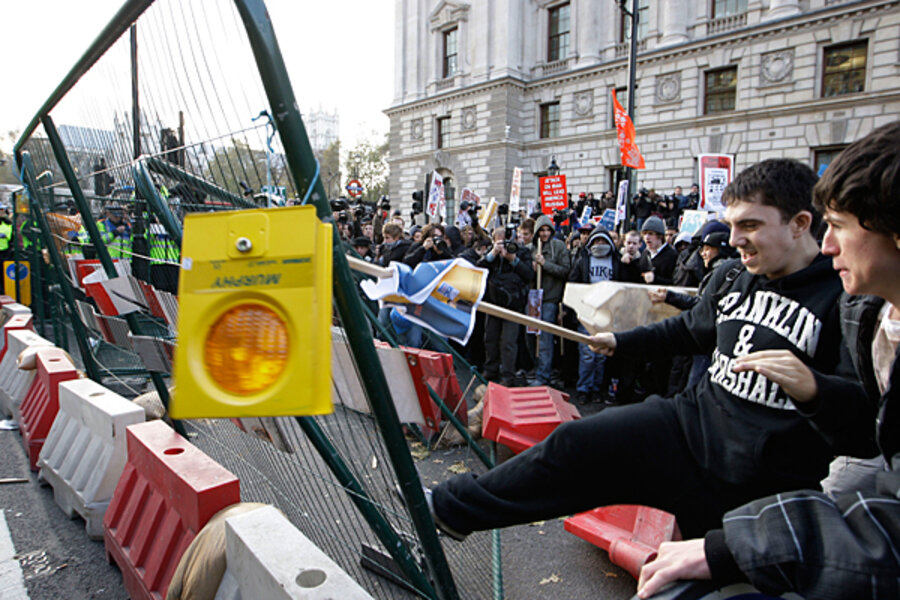British students return to streets, vowing to press on against tuition hikes
| London
Suddenly, austerity Britain in 2010 is beginning to resemble Left Bank Paris in 1968.
Or so it might have seemed Wednesday to onlookers witnessing a coordinated wave of student walkouts, occupations, and protests around the country as part of the campaign against government plans to raise the cost of studying at a university to up to $14,000 a year (three times the current rate).
Although protests this morning started peacefully, the calm began to fade at lunchtime as police struggled to contain thousands of students near government buildings in the Whitehall area of central London.
A small number of demonstrators hurled burning placards at riot police as a police van was isolated and attacked.
Two weeks after small bands of students clashed with police during demonstrations that involved as many as 50,000 students, all indications are that many students remain intent on using direct action to confront the government over the increases.
“There are new people coming to the movement – that is very noticeable,” says Clare Solomon, the president of the University of London student’s union, whose group is among the more militant student organizations.
The Internet is playing a central role in drawing more students to Ms. Solomon's cause. In fact, students in the city of Plymouth installed a live webcam to record their occupation of university buildings. Tens of thousands of high school, college, and university students who pledged on Facebook to walk out of classes began making their move at 11 a.m. Wednesday.
Elsewhere, parliamentarians from the governing coalition parties – the Conservatives and Liberal Democrats – were expected to close their offices over police warnings they could be targeted for student occupation. The officer in charge of monitoring "domestic extremism" in Britain said there would be a focus on "fringe" elements where protests could "spill over" into violence.
The police admitted they were “embarrassed” by their handling of the Nov. 10 protests, in which dozens were arrested for smashing windows and starting fires at Conservative Party headquarters. A student pleaded guilty Wednesday to throwing a fire extinguisher from the building’s roof.
The police presence – including riot squads – was heavier this time on the streets of London, where a rally in Trafalgar Square was planned to follow the walkouts.
Solomon says that students want the government to back away from passing legislation that would lead to the tuition hikes.
“We are looking at more radical forms of direct action. In terms of occupations of universities, this is in the context of a way in which students can exert pressure on their management, which can in turn exert pressure on the government,” she added.
The Liberal Democrats have been a particular focus for student anger, given that the party’s members signed a pledge during this year's election campaign to vote against any rise in student fees.
Nick Clegg, the deputy prime minister and Liberal Democrat leader, was expected to be a primary target of the student unions. Mr. Clegg defended the tuition hikes in a speech Tuesday, describing the policy as the best available in the circumstances.
"I make just one request of those planning to protest: examine our proposals before taking to the streets," he said. "Listen and look before you march and shout."





